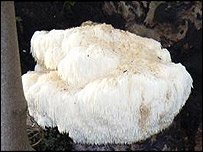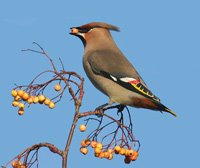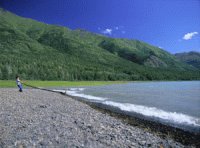
Wish you Happiness and Joy...
And Blessings for the New Year.
Wish you the best of everything...
That you so well deserve.
HAPPY NEW YEAR TO ALL OF YOU !!!

 A rare fungus named after a hedgehog because of its spiky football shape has been found in a Brighton park.
A rare fungus named after a hedgehog because of its spiky football shape has been found in a Brighton park. The tiny rabbit-like American pika, an animal species considered to be one of the best canaries in a coal mine for detecting global warming in the western United States, appears to be veering toward the brink of extinction in the Great Basin.
The tiny rabbit-like American pika, an animal species considered to be one of the best canaries in a coal mine for detecting global warming in the western United States, appears to be veering toward the brink of extinction in the Great Basin."Human influences have combined with factors such as climate change operating over longer time scales to produce the diminished distribution of pikas in the Great Basin today. This makes controlling our current impacts on them all that more important," said Grayson.The animals are isolated in patches across mountainous areas in western North America, from the southern Sierra Nevada and Rocky mountains to central British Columbia in Canada. In the Great Basin, these mountains are separated by large valleys with desert-like conditions that pikas can't tolerate. Pikas live in rock-strewn talus slopes that provide them with air-conditioning from hot temperatures and protection from predators.
 Elvis. That is the nickname that Larry Mallard, refuge manager for the White River National Wildlife Refuge in southeastern Arkansas, uses for the ivory-billed woodpecker (Campephilus principalis), now being sought in Mallard’s woods by Cornell Lab of Ornithology staffers and volunteers.
Elvis. That is the nickname that Larry Mallard, refuge manager for the White River National Wildlife Refuge in southeastern Arkansas, uses for the ivory-billed woodpecker (Campephilus principalis), now being sought in Mallard’s woods by Cornell Lab of Ornithology staffers and volunteers.
 A love motel in Soa Paulo has opened for amorous dogs. The love motel offers decorated rooms for dogs of pet owners who are concerned for their animal's needs.
A love motel in Soa Paulo has opened for amorous dogs. The love motel offers decorated rooms for dogs of pet owners who are concerned for their animal's needs. If you have, then you are one of the lucky few this winter and the British Trust for Ornithology wants to hear from you. Waxwings are stunning winter visitors from Scandinavia and Russia. Arriving here in late autumn in search of berries they may appear in gardens and supermarket car parks. The BTO/CJ Garden BirdWatch Survey needs your help to find out which gardens they are visiting and where.
If you have, then you are one of the lucky few this winter and the British Trust for Ornithology wants to hear from you. Waxwings are stunning winter visitors from Scandinavia and Russia. Arriving here in late autumn in search of berries they may appear in gardens and supermarket car parks. The BTO/CJ Garden BirdWatch Survey needs your help to find out which gardens they are visiting and where.Martin Fowlie, of the BTO/CJ Garden BirdWatch Team, said "We want garden owners around the country to tell us whether they have any visiting Waxwings this winter. Hearing from people who don't have Waxwings is just as important as hearing from those that do, so we can build up an accurate picture of where these birds are. Waxwings are very distinctive birds, about the size of a Starling, with a brown crest and bright red, wax-like, tips to some of their wing feathers, hence their name."To be part of the ‘Waxwing Watch’ and to receive a free information pack, phone on 01842 750050 or write to Waxwing Watch, Garden Bird Watch, British Trust for Ornithology, The Nunnery, Thetford, Norfolk IP24 2PU.
 The strange, half-human creatures in the image above are neither real nor a hoax; they are part of a sculpture by Australian artist Patricia Piccinini entitled "The Young Family," which, in turn, is part of a larger installation called "We Are Family," described by Jane Silversmith of the Australian Council for the Arts as an exploration of "the changing relationship between what is considered natural and what is considered artificial."
The strange, half-human creatures in the image above are neither real nor a hoax; they are part of a sculpture by Australian artist Patricia Piccinini entitled "The Young Family," which, in turn, is part of a larger installation called "We Are Family," described by Jane Silversmith of the Australian Council for the Arts as an exploration of "the changing relationship between what is considered natural and what is considered artificial." A restless volcano near Alaska's most populated region is being watched by scientist and officials, who warned on Thursday of the risk of clouds of ash and a tsunami from a possible eruption.
A restless volcano near Alaska's most populated region is being watched by scientist and officials, who warned on Thursday of the risk of clouds of ash and a tsunami from a possible eruption. Looks like a tasty addition to your dish ? Though it looks scary, but Clarence Olberding just cant wait to smoke it up & eat it.
Looks like a tasty addition to your dish ? Though it looks scary, but Clarence Olberding just cant wait to smoke it up & eat it."I reached down and grabbed it to take the hook out and that's when I noticed that the hook was in the upper mouth and there was another jaw protruding out below," the 57-year-old said.
In his 40 years of fishing, Olberding has seen fish with missing fins — and a fish with one eye — but he’d never seen two mouths.
 Planting trees willy-nilly to counter increased carbon dioxide concentrations in the atmosphere may actually result in other environmental damage, new research shows.
Planting trees willy-nilly to counter increased carbon dioxide concentrations in the atmosphere may actually result in other environmental damage, new research shows.A specific molecular mixture in male-emitted pheromones has been detected which attracts female elephants' interest during musth - an annual period of sexual activity and increased aggression.
Not only does the exact chemical blend of a pheromone emitted by older male elephants in musth influence female elephants` interest in mating, but also determines how other nearby elephants behave.
 Scientists are unable to explain the reason behind the steady decline in the number of pupfish. The Desert pupfish was first listed on March 31, 1986. It is currently designated as Endangered species. This species is known to occur in Arizona, California and Mexico.
Scientists are unable to explain the reason behind the steady decline in the number of pupfish. The Desert pupfish was first listed on March 31, 1986. It is currently designated as Endangered species. This species is known to occur in Arizona, California and Mexico.Jim Deacon, a University of Nevada-Las Vegas biologist, said, 'The expected increase this fall did not happen. All through last summer there was egg-laying and babies produced, but not enough to increase the adult population, so we're still at very dangerous levels.'Unless we do something quickly, they will disappear forever.
'It doesn't look like there was a change in the ecological relationships,' Deacon told the Sun. 'One easy cop out is to say there is a genetic bottleneck, but I think that's too easy.
 The shifting sands of time have revealed Australia's earliest human footprints, giving a glimpse of life at the height of the last ice age.
The shifting sands of time have revealed Australia's earliest human footprints, giving a glimpse of life at the height of the last ice age. A striped aquarium fish has helped scientists find a gene that plays a role in determining human hair, skin and eye colour.
A striped aquarium fish has helped scientists find a gene that plays a role in determining human hair, skin and eye colour. On a day of near-record high temperatures in Anchorage, a dramatic announcement from scientists in the United Kingdom, 2005 was the warmest year on record in the Northern Hemisphere. The news comes in the wake of a new finding by researchers at the University of Alaska Fairbanks. Alaska's lakes appear to be draining into the state’s thawing tundra.
On a day of near-record high temperatures in Anchorage, a dramatic announcement from scientists in the United Kingdom, 2005 was the warmest year on record in the Northern Hemisphere. The news comes in the wake of a new finding by researchers at the University of Alaska Fairbanks. Alaska's lakes appear to be draining into the state’s thawing tundra. Not only is the air around the Tibetan plateau thin but it's also thick with ozone, posing a medical danger to mountaineers, says a new study by researcher at the University of Toronto.
Not only is the air around the Tibetan plateau thin but it's also thick with ozone, posing a medical danger to mountaineers, says a new study by researcher at the University of Toronto. When Genghis Khan set out to unify the Mongolian tribes in the thirteenth century, the man whose ruthless ambition would bind most of Eurasia into the greatest empire in history began with the tribes of an obscure northern valley, the Darkhat. Today lying near the border with Siberian Russia, the Darkhat Valley marks the boundary between the vast central Asian steppe and the forested Siberian taiga. From the earliest times, this region has been a crossroads, a place where the worlds of Central Asia and the Arctic met. The result is a landscape littered with dramatic archaeological monuments, especially huge rock burial mounds known as khirigsuurs and upright stones carved with mysterious symbols.
When Genghis Khan set out to unify the Mongolian tribes in the thirteenth century, the man whose ruthless ambition would bind most of Eurasia into the greatest empire in history began with the tribes of an obscure northern valley, the Darkhat. Today lying near the border with Siberian Russia, the Darkhat Valley marks the boundary between the vast central Asian steppe and the forested Siberian taiga. From the earliest times, this region has been a crossroads, a place where the worlds of Central Asia and the Arctic met. The result is a landscape littered with dramatic archaeological monuments, especially huge rock burial mounds known as khirigsuurs and upright stones carved with mysterious symbols.